class: center, middle, inverse, title-slide # Disorder and Social Control ### Ross Matsueda<br>Chuck Lanfear<br>Lindsey Beach ### Oct 26, 2018 --- # Outline 1. Theoretical Framework 2. Project Structure 3. Experiments * Lost Letter * Mailbox Experiment * Littering Intervention * Litter Clean-Up 4. Synthesis 5. Appendix --- class: inverse # Theoretical Framework ### Neighborhood social control and crime ??? Our focus crime Crime always has risks Prosocial action does not always have risk but risk is an underappreciated element --- # Broken Windows [Wilson & Kelling (1982)](https://www.theatlantic.com/magazine/archive/1982/03/broken-windows/304465/) describe a system where community disorder (1) increases crime by signalling low social control to offenders and (2) decreases actual social control by reducing willingness to use public spaces. -- .pull-left60[  ] .pull-right40[ * A: Disorder signals low guardianship which increases offending. * B, E: Disorder and crime constrain social relations and impede control. * C, D: Social control inhibits both disorder and crime. ] .centernote[ *This model is under-identified without instruments or manipulations* ] --- # Collective Efficacy [Sampson & Raudenbush (1999)](https://doi.org/10.1086/210356) contend that disorder and crime are both manifestations of low collective efficacy—the community's capacity for informal social control. -- .pull-left60[  ] .pull-right40[ * C, D: Disorder and crime are products of low collective efficacy—social control—which is exogenous (B, E). * A: Disorder has no direct impact on crime. ] .centernote[ *A, B, and E represent testable constraints on Broken Windows.* ] --- class: inverse # Key Studies ### [Keizer, Lindenberg, & Steg (2008)](https://doi.org/10.1126/science.1161405) ### [Sampson & Raudenbush (1999)](https://doi.org/10.1086/210356) --- ## Keizer, Lindenberg, & Steg (2008) Used disorder manipulations and recorded norm violation with field experiments in Grongingen, the Netherlands. Multiple interventions show a consistent positive relationship. -- .pull-left[  ] .pull-right[ * Powerful causal effect of disorder on multiple forms of norm violation (A). * Single sites in one city: No examination of context, indirect pathways, or reciprocal effects. * High **internal validity** from experimental design. ] --- ## Sampson & Raudenbush (1999) Simultaneous equations of crime, disorder, and collective efficacy in Chicago neighborhoods, using survey-measured collective efficacy and a novel objective measure of disorder: Video of block faces coded by researchers. -- .pull-left[  .small[<sup>*</sup> Effect found only for robbery.] ] .pull-right[ * Effect of disorder on crime (A) absent once controlling for collective efficacy (B,D) * Control for crime impact on collective efficacy (E), but assume no disorder feedback on collective efficacy (C) * High **external validity** using focal concepts: *Real* disorder and crime. ] --- # Key Question ### How do we reconcile these results? -- ### *But first, an aside...* --- # Prosocial Behavior and Risk Our focus is on crime—which always has risks—but both Broken Windows and Collective Efficacy are also theories of **prosocial behavior**. -- Broken windows implies disorder attenuates prosocial behavior through *fear of crime* and subsequent withdrawal from community life. -- Collective efficacy predicts many prosocial behaviors:<sup>1</sup> * Returning lost letters * Voting * Providing CPR * Sanctioning norm-violators .footnote[[1] [Sampson (2012)](https://www.press.uchicago.edu/ucp/books/book/chicago/G/bo5514383.html)] -- Engaging in social control—sanctioning—is a *risky prosocial behavior*. -- Prosocial action does not always feature risk but *risks and costs of prosocial behavior are underappreciated elements*. --- # Research Questions Our goal is testing the micro-level mechanisms that underlie Broken Windows and Collective Efficacy. -- Does disorder increase norm-violations and crime as suggested by Broken Windows? * Does disorder also inhibit prosocial behavior? -- Or is this relationship spurious once collective efficacy is controlled, as suggested by Sampson? * Is activation of collective efficacy conditional on context? * Does disorder moderate collective efficacy? * Does collective efficacy limit exposure to disorder via clean-up? -- .centernote[ *To answer these questions, this study links field experiments embedded in Seattle neighborhoods to ecometric data from the 2002-2003 Seattle Neighborhoods and Crime Survey.* ] --- class: inverse # Project Structure --- # Experiments and Goals 1. **Lost Letter** * Obtain updated measure of collective efficacy. -- 2. **Mailbox Experiment** * Test causal effect of disorder on crime and norm-violation (A). -- 3. **Littering Intervention** * Test causal effect of disorder on sanctioning (B). * Test causal effect of interpersonal context on sanctioning. * Measure association of collective efficacy with sanctioning. -- 4. **Litter Clean-Up** * Measure assocation of collective efficacy with disorder removal (D). --- # Experiment Diagram  ??? Paths E and C are hard to isolate Can't use crime as an intervention Crime is a rare event to observe Sanctioning is difficult intervention --- <img src="SNCP_SocSem_102618_files/figure-html/unnamed-chunk-1-1.svg" width="78%" /> --- <!-- --> --- class: inverse # The Experiments --- # Lost Letter: Method 2,938 letters were dropped on Seattle sidewalks for passersby to encounter. -- 24 letters—8 per addressee—were dropped in each census tract: * Charles F. Landers Sr. (Personal) * Friends of Black Lives Matter (BLM) * American Neo-Nazi Party (Nazi) -- Mailed letters were received at a PO Box monitored by the research team. -- Letter ID numbers combine with hand-recorded drop locations to permit geotagging of letter returns.<sup>1</sup> .footnote[[1] Letter condition, area type (e.g. residential), and postmark date were also recorded. Addresses have also now been linked to election precincts (See Appendix).] --- # Lost Letter: Model .pull-left[  ] .pull-right[ * Returning a lost letter is a low-risk pro-social intervention highly correlated with collective efficacy (G)<sup>1</sup>. ] .footnote[ [1] See [Sampson (2012)](https://www.press.uchicago.edu/ucp/books/book/chicago/G/bo5514383.html) and [Milgram, Mann, and Harter (1965)](https://doi.org/10.1086/267344). <br> <br> <br> ] --- # Lost Letter: Model .pull-left[  ] .pull-right[ * Returning a lost letter is a low-risk pro-social intervention highly correlated with collective efficacy (G)<sup>1</sup>. * This may be used to update the 2002-2003 SNCS collective efficacy measures which may have shifted over time.<sup>2</sup> ] .footnote[ [1] See [Sampson (2012)](https://www.press.uchicago.edu/ucp/books/book/chicago/G/bo5514383.html) and [Milgram, Mann, and Harter (1965)](https://doi.org/10.1086/267344). [2] Note however that collective efficacy is persistent ([Sampson 2012](https://www.press.uchicago.edu/ucp/books/book/chicago/G/bo5514383.html)). ] --- # Lost Letter: Model .pull-left[  ] .pull-right[ * Returning a lost letter is a low-risk pro-social intervention highly correlated with collective efficacy (G)<sup>1</sup>. * This may be used to update the 2002-2003 SNCS collective efficacy measures which may have shifted over time.<sup>2</sup> * Varying the addressee tests sensitivity of prosocial intervention to context. ] .footnote[ [1] See [Sampson (2012)](https://www.press.uchicago.edu/ucp/books/book/chicago/G/bo5514383.html) and [Milgram, Mann, and Harter (1965)](https://doi.org/10.1086/267344). [2] Note however that collective efficacy is persistent ([Sampson 2012](https://www.press.uchicago.edu/ucp/books/book/chicago/G/bo5514383.html)). ] --- # Lost Letter: Results <table style="width:70%"> <tr> <td style="font-size:115%" colspan="5">Lost Letter: Returned Letters</td> </tr> <tr> <th>Return Rate</th> <th>Mean</th> <th>Min</th> <th>Max</th> <th>Corr(CE)</th> </tr> <tr> <td>Personal</td> <td>.793</td> <td>.375</td> <td>1.000</td> <td>.346</td> </tr> <tr> <td>BLM </td> <td>.711</td> <td>.250</td> <td>1.000</td> <td>.318</td> </tr> <tr> <td>Nazi</td> <td><strong>.240</strong></td> <td><strong>.000</strong></td> <td>.625</td> <td><strong>.034</strong></td> </tr> <tr> <td>All Letters</td> <td>.581</td> <td>.375</td> <td>.833</td> <td>.340</td> </tr> </table> Key Findings: * Personal (0.346) and BLM (0.318) returns correlated with 2002-2003 collective efficacy. -- * Nazi letter returns uncorrelated with CE (.034) and less common. -- * Return rates of Personal and BLM letters should provide a valid updated collective efficacy indicator. -- .footnote[ [This experiment also resulted in media coverage (Crosscut, 2016).](http://crosscut.com/2016/10/uw-study-seems-to-equate-black-lives-matter-and-nazis/) ] ??? Logit model indicates CE predicts BLM and personal letters Interaction with Nazi negates CE effect BLM has a lower base return rate --- # Mailbox: Method .pull-left[ .image-75[ 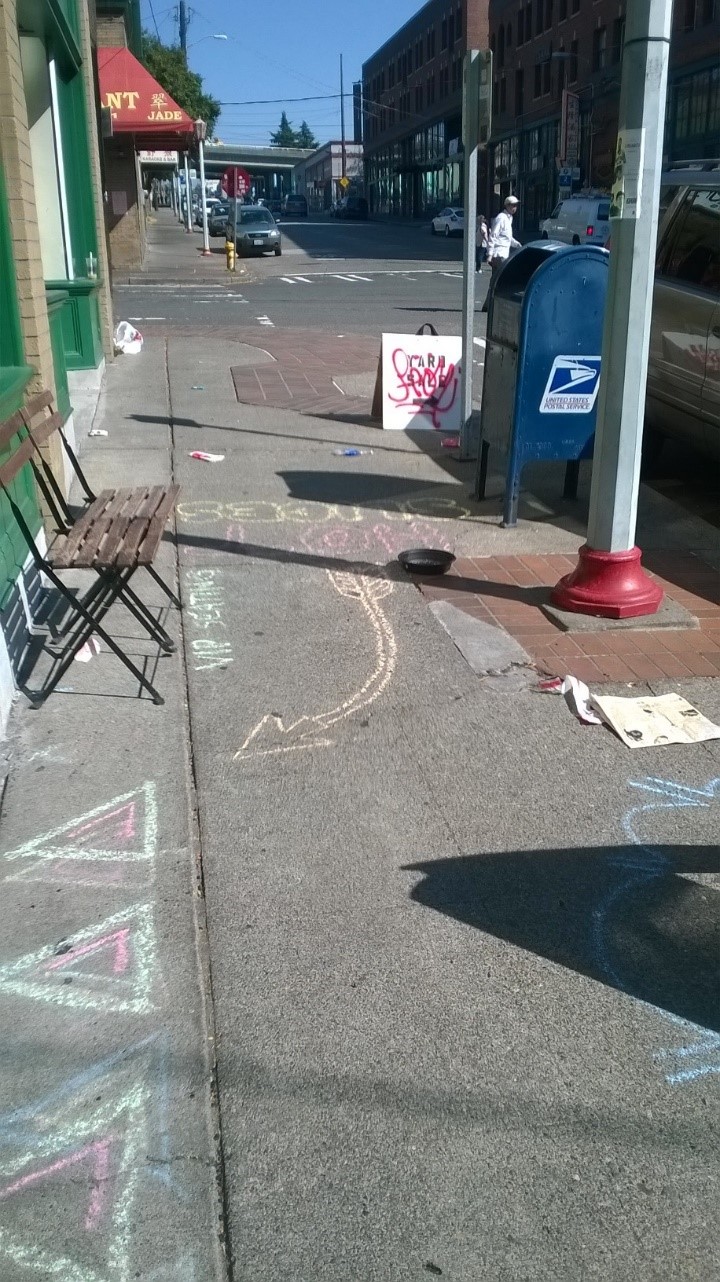 ] ] * A letter containing a visible $5 bill is left near mailbox for passersby to encounter. -- * Litter and a sign board with graffiti are introduced to manipulate disorder. -- * Researchers record whether participants mail, steal, or ignore the envelope.<sup>1</sup> .footnote[[1] Perceived sex, age, and group size of participants were also recorded to adjust for compositional differences of tracts.] -- * We conducted 405 trials with 3,671 participants in 20 Seattle census tracts. --- # Mailbox: Model .pull-left[  ] .pull-right[ * Causal test of direct effect of disorder on crime (A). ] --- # Mailbox: Model .pull-left[  ] .pull-right[ * Causal test of direct effect of disorder on crime (A). ] --- # Mailbox: Model .pull-left[  ] .pull-right[ * Causal test of direct effect of disorder on crime (A). * Causal test of direct effect of disorder on low-risk prosocial behavior (J). ] --- # Mailbox: Model .pull-left[  ] .pull-right[ * Causal test of direct effect of disorder on crime (A). * Causal test of direct effect of disorder on low-risk prosocial behavior (J). * Capture association between collective efficacy and minor crime (C) and low-risk prosocial behavior (K). ] --- # Mailbox: Results <table style="width:70%"> <tr> <td style="font-size:115%" colspan="5">Mailbox: Participant Actions</td> </tr> <tr> <th>Condition</th> <th>Walk-By</th> <th>Mail</th> <th>Theft</th> <th>Sum</th> </tr> <tr> <td rowspan="2">Control</td> <td>1629</td> <td>208</td> <td>33</td> <td>1870</td> </tr> <tr> <td>.871</td> <td><strong>.111</strong></td> <td><strong>.018</strong></td> <td>.509</td> </tr> <tr> <td rowspan="2">Treatment</td> <td>1637</td> <td>136</td> <td>28</td> <td>1801</td> </tr> <tr> <td>.909</td> <td><strong>.076</strong></td> <td><strong>.016</strong></td> <td>.491</td> </tr> <tr> <td rowspan="2">Both</td> <td>3266</td> <td>344</td> <td>61</td> <td>3671</td> </tr> <tr> <td>.890</td> <td>.094</td> <td>.017</td> <td>1.000</td> </tr> </table> Key Findings: * Disorder has no impact on theft.<sup>1</sup> .footnote[[1] There is no significant positive relationship in *any* location.] -- * Disorder reduces the likelihood of mailing—resulting in the letter remaining on the ground longer. -- * Collective efficacy is associated with lower theft, but not more mailing. --- ## Littering Intervention: Method A confederate walks down the street and flagrantly litters near a trash can in view of passersby. -- Researchers record whether the confederate is sanctioned—a risky prosocial behavior—or the litter is disposed of by a participant—a low-risk prosocial behavior. -- Litter and a sign board with graffiti are introduced to manipulate disorder. -- Replicated with three confederates of varying sex and race to manipulate interpersonal context which may influence evaluations of risk:<sup>1</sup> * Black Male * White Male * White Female .footnote[[1] Sex and race also interact with normative expectations.] -- We conducted 576 trials in 12 Seattle census tracts. --- # Littering Intervention: Model .pull-left[  ] .pull-right[ * Test of direct effect of disorder on sanctioning (B). ] --- # Littering Intervention: Model .pull-left[  ] .pull-right[ * Test of direct effect of disorder on sanctioning (B). * Norm-Violation is *fixed*—all relationships are conditional on the offense occurring. ] --- # Littering Intervention: Model .pull-left[  ] .pull-right[ * Test of direct effect of disorder on sanctioning (B). * Norm-Violation is *fixed*—all relationships are conditional on the offense occurring. * Test effect of interpersonal context of norm violation on sanctioning (L). ] --- # Littering Intervention: Model .pull-left[  ] .pull-right[ * Test of direct effect of disorder on sanctioning (B). * Norm-Violation is *fixed*—all relationships are conditional on the offense occurring. * Test effect of interpersonal context of norm violation on sanctioning (L). * Captures association between collective efficacy and sanctioning (M). ] --- # Results: Sanctions <table style="width:70%"> <tr> <td style="font-size:115%" colspan="5">Litter Intervention: Sanctions</td> </tr> <tr> <th><br>Condition</th> <th>Black<br>Male</th> <th>White<br>Male</th> <th>White<br>Female</th> <th><br>All</th> </tr> <tr> <td rowspan="2">Control</td> <td>2</td> <td>2</td> <td>9</td> <td>13</td> </tr> <tr> <td><strong>.021</strong></td> <td><strong>.021</strong></td> <td><strong>.103</strong></td> <td>.045</td> </tr> <tr> <td rowspan="2">Treatment</td> <td>1</td> <td>8</td> <td>4</td> <td>13</td> </tr> <tr> <td><strong>.011</strong></td> <td><strong>.091</strong></td> <td><strong>.043</strong></td> <td>.045</td> </tr> <tr> <td rowspan="2">Both</td> <td>3</td> <td>10</td> <td>13</td> <td>26</td> </tr> <tr> <td>.016</td> <td>.052</td> <td>.068</td> <td>.045</td> </tr> </table> Key Findings: * No *unconditional* effect of disorder on sanctions—a risky prosocial action. * Disorder *interacts* with confederate race/gender. -- * Collective efficacy and letter returns did not predict sanctioning (M). -- * Sanctioning varies widely by confederate in both *quantity* and *content*. * White female received more *aggressive* sanctions, usually from men. * Black male received *passive* sanctions only from women. * White male received *balanced* sanctions. ??? LB: 11/13 from men TP: 3 sanctions from women CL; 6/10 sanctions from men --- # Results: Throwing Away <table style="width:70%"> <tr> <td style="font-size:115%" colspan="5">Litter Intervention: Throw-Aways</td> </tr> <tr> <th><br>Condition</th> <th>Black<br>Male</th> <th>White<br>Male</th> <th>White<br>Female</th> <th><br>All</th> </tr> <tr> <td rowspan="2">Control</td> <td>3</td> <td>7</td> <td>7</td> <td>17</td> </tr> <tr> <td><strong>.032</strong></td> <td>.079</td> <td>.079</td> <td><strong>.059</strong></td> </tr> <tr> <td rowspan="2">Treatment</td> <td>3</td> <td>3</td> <td>4</td> <td>10</td> </tr> <tr> <td><strong>.032</strong></td> <td>.032</td> <td>.043</td> <td><strong>.035</strong></td> </tr> <tr> <td rowspan="2">Both</td> <td>6</td> <td>10</td> <td>11</td> <td>27</td> </tr> <tr> <td>.032</td> <td>.052</td> <td>.057</td> <td>.047</td> </tr> </table> We also evaluated if our interventions impacted throwing away the dropped litter—a low risk, non-confrontational prosocial action. -- Key Findings: * Disorder treatment reduces throwing away. * This effect also conditional on confederate characteristics. -- * Collective efficacy and letter returns do not predict throwing away. --- # Litter Clean-Up: Method .pull-left[ .image-full[ 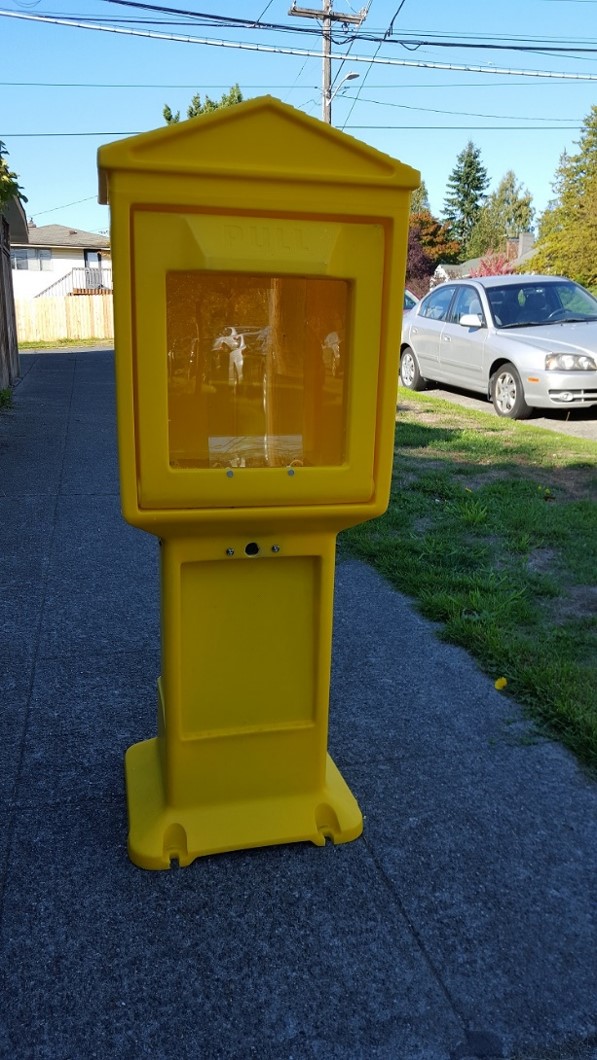 ] ] .pull-right[ * A variety of trash is dropped on a sidewalk. ] --- # Litter Clean-Up: Method .pull-left[ .image-full[  ] ] .pull-right[ * A variety of trash is dropped on a sidewalk. * A magazine rack with concealed camera and motion detector records when the litter is cleaned up and how many people pass by. ] --- # Litter Clean-Up: Method .pull-left[ .image-full[ 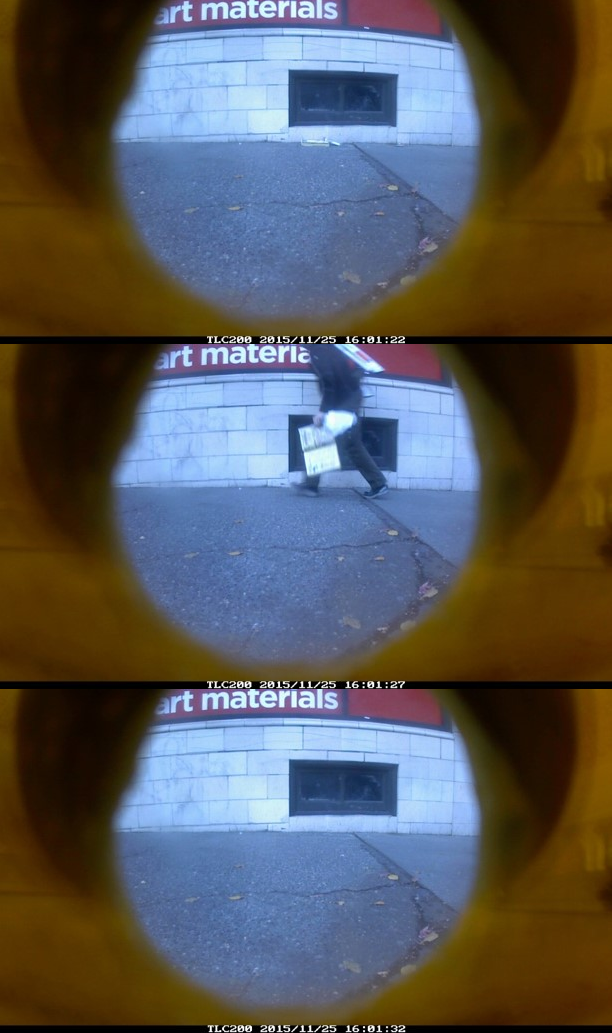 ] ] .pull-right[ * A variety of trash is dropped on a sidewalk. * A magazine rack with concealed camera and motion detector records when the litter is cleaned up and how many people pass by. * This permits capturing the relationship between collective efficacy and time to remove disorder. ] --- # Litter Clean-Up: Method .pull-left[ .image-full[  ] ] .pull-right[ * A variety of trash is dropped on a sidewalk. * A magazine rack with concealed camera and motion detector records when the litter is cleaned up and how many people pass by. * This permits capturing the relationship between collective efficacy and time to remove disorder. * An alternate magazine rack defaced by graffiti and stickers is swapped in to manipulate disorder. ] --- # Litter Clean-Up: Results .pull-left[ .image-full[ 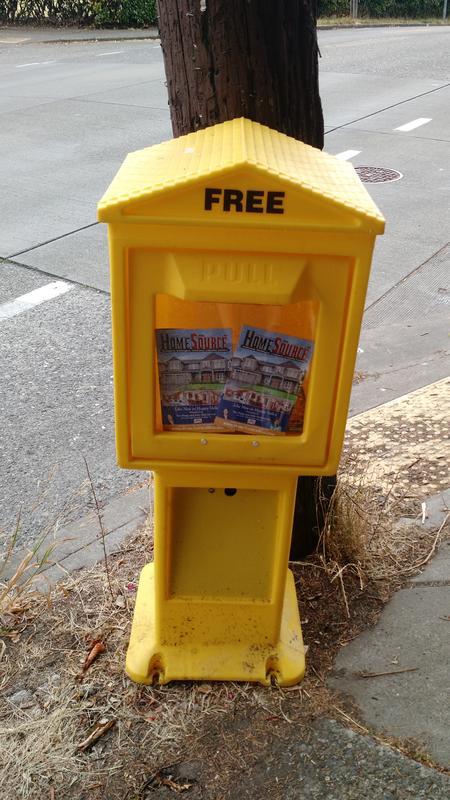 ] ] * The experiment was abandoned after a small number of trials. --- # Litter Clean-Up: Results .pull-left[ .image-full[ 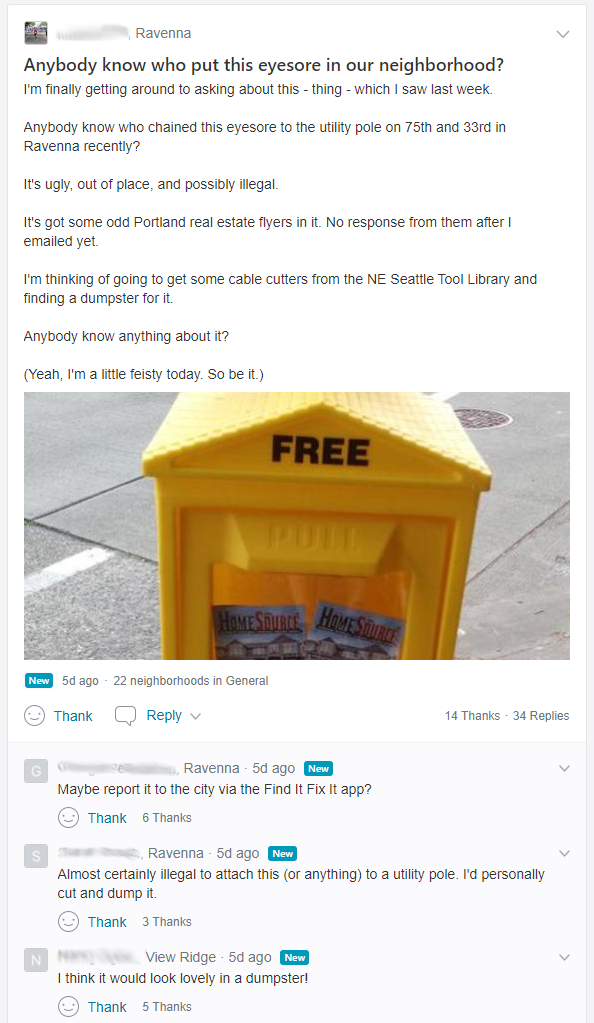 ] ] * The experiment was abandoned after a small number of trials. * In Ravenna, residents reported the magazine racks on Nextdoor as an "eyesore". -- * Two magazine racks had locks cut and were removed. -- * Thus we were unable to continue experiment *because of collective efficacy* in an affluent neighborhood. -- * In contrast, one rack was left *for an entire year* in Capitol Hill without issue. ??? Maybe talk about Coleman and zeal --- class: inverse # Synthesis --- # Synthesis 1 .pull-left[  ] .pull-right[ 1\. No disorder effect on theft (A). * Unable to replicate Keizer et al. (2008) 2\. Disorder attenuates low-risk, low-cost prosocial actions—mailing letters, throwing away litter—and possibly sanctioning as well (B). * Consistent with indirect Broken Windows pathway. * Suggests feedback effect on collective efficacy. ] --- # Synthesis 2 .pull-left[  ] .pull-right[ 3\. Collective efficacy predicts some low-risk prosocial action (H,K) but not higher risk actions—sanctioning. * Sanctioning is thought to be a key mechanism. * May have insufficient power to detect effect. 4\. Collective efficacy is associated with lower theft (C). * Unable to explore mechanism. * Possibly correlated with perceived *risk* of sanction or population composition. ] --- # Synthesis 3 .pull-left[  ] .pull-right[ 5\. Context matters for prosocial behavior (I). * Addresses of letters impact mailing. * Target characteristics impact sanctioning.<sup>1</sup> * Activation of collective efficacy is task and context specific.<sup>2</sup> .footnote[ [1] Sanctioning on the basis of race hardly seems "prosocial". See Lanfear, Beach, & Thomas (2018) (forthcoming). [2] See [St. Jean (2007)](https://www.press.uchicago.edu/ucp/books/book/chicago/P/bo5298963.html) and [Wickes et al. (2013)](https://www.ncbi.nlm.nih.gov/pubmed/23812906). ] ] --- # Prosocial Behavior ### Future research *We know relatively little about the activation of prosocial behavior, particularly sanctioning.* -- This study suggests contexts of prosocial behavior are important but neglected considerations for neighborhood theories of crime. -- * Collective efficacy is correlated with the presence of risk factors—such as retaliation from the sanctioned. -- * Disorder may be a signal for risks or other costs. -- * Disorder may signal that interventions will have limited benefit. -- * Context may cause general statements of prosocial intentions to differ sharply from actual behavior (see [St. Jean 2007](https://www.press.uchicago.edu/ucp/books/book/chicago/P/bo5298963.html)). --- # Acknowledgements Our findings are the result of over 2000 person-hours of field work over four summers. This project was made possible by the participation of graduate student researchers, grant funding, and institutional resources on campus. .pull-left[ ### Researchers Anquinette Barry Chris Hess John Leverso Kate O'Neill Terrence Pope ] .pull-right[ ### Funding National Science Foundation UW Royalty Research Fund ### Support Center for Statistics and the Social Sciences Center for Studies in Demography and Ecology ] --- # Sampling .image-full[  ] --- # Lost Letter Elections  --- # Mailbox Models .center[Two Mailbox Multinomial Models] | | Mail | Theft | Mail | Theft | |:------------------:|:--------:|:--------:|:---------:|:--------:| | (Intercept) | **-2.053** | 0.332 | **-1.467** | -1.437 | | | *(0.538)* | *(1.170)* | *(0.579)* | *(1.329)* | | Treatment | **-0.275** | -0.081 |**-0.263** | -0.098 | | | *(0.118)* | *(0.261)* | *(0.119)* | *(0.263)* | | Coll. Eff. | 0.265 | **-1.206** | 0.171 | -0.804 | | | *(0.173)* | *(0.396)* | *(0.181)* | *(0.424)* | | Walk-by Rate | **-0.564** | -**0.535** | **-0.534** | **-0.429** | | | *(0.063)* | *(0.132)* | *(0.064)* | *(0.133)* | | Male | | | -0.094 | **0.880** | | | | | *(0.117)* | *(0.296)* | | Non-White | | | **-0.459** | 0.397 | | | | | *(0.144)* | *(0.272)* | | In Group | | | **-0.876** | **-1.302** | | | | | *(0.161)* | *(0.475)* | ??? CE predicts people being in groups CE predicts fewer men; maybe proxying employment? --- # LitterCam Disorder .image-full[  ] --- # LitterCam Equipment .image-full[  ] --- # Litter Clean-Up: Alternative We supposed the speed of return of lost letters was correlated with clean-up time of trash. As a pilot, in selected trats, 24 pieces of litter were dropped in the same locations as lost letters and then checked three times over the course of a day. Neither timing nor a binary measure of clean-up were found to be associated with either lost letter returns or overall collective efficacy. --- ## Sampson & Raudenbush Replication We replicated Sampson & Raudenbush (1999) but with an instruments for disorder and collective efficacy from Miethe (1990) to examine reciprocal effects. * Disorder in 2002-2003 instrumented by 1990 disorder. * Collective Efficacy in 2002-2003 instrumented by 1990 social cohesion, reciprocated exchange, and intergenerational closure. Key Findings: * Disorder predicts crime in both high and low crime neighborhoods. * Collective efficacy only predicts crime in low crime neighborhoods. * Disorder and collective efficacy have bidirectional negative relationship.